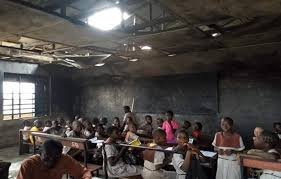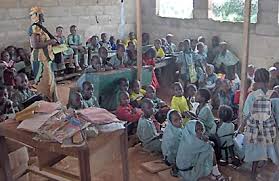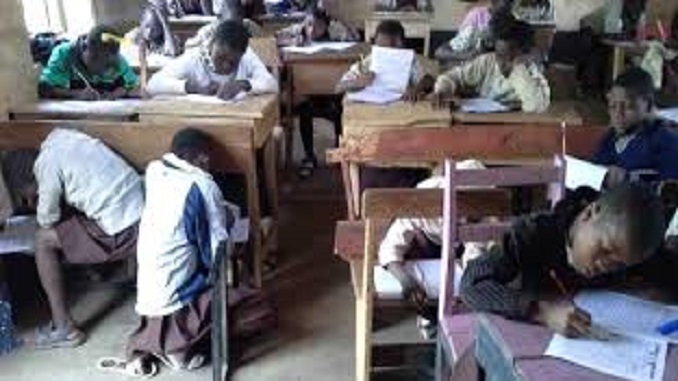As Nigeria’s rich continue sending their kids overseas to obtain quality education, the educational system in country continues to flounder.
Ironically, it is the investments the host countries of these foreign schools made in their educational system that made them attractive. Today government office holders who could transform Nigeria’s educational fortunes choose instead to send their wards abroad to obtain that, which the country cannot offer.
Meanwhile, China which celebrates its national day on October 1st like Nigeria has bounded years ahead of the 59 year old. Its educational system is in a different realm. Nigeria does not even come close.
The Blueprint Newspaper on March 2, 2019 wrote on: The worsening state of Nigeria’s education. Eleojo Idachaba in that article posited as follows:
Earlier, in 2017, President Buhari while declaring open the presidential retreat for members of the Federal Executive Council (FEC) at the Old Banquet Hall, Abuja, bemoaned the state of education in the country. According to the president, “The state of education in Nigeria calls for a serious concern and that is why we are all gathered here today. The problem is no longer a secret that the quality of education in Nigeria requires greater attention and improvement.”
“That our country is facing numerous challenges in education and all other sectors as a result of historical abuses, mindless impunity and corruption is not news to anyone. With an estimated 13.2 million children out of school, high illiteracy level, infrastructural deficit and decay, unqualified teachers, and inadequate instructional materials, to mention some of the challenges, we can clearly see the effect of decades of neglect that the education sector has suffered. We are determined to turnaround the sector for the better. We are already making appreciable progress in this respect. This summit must, therefore, among other things, sharpen our strategies for addressing the challenges of basic and secondary education, teacher training and professional development, technical and vocational education,” he said.
An analyst’s view
Writing on the deplorable state of education, an education analyst, Yaz Abubakar, said Nigeria urgently needs to improve school standards to reverse years of decay in education and prevent the sector from falling further.
He said: “The Nigerian education system has undoubtedly failed millions of children and we need systematic change across the country to redress the problem. Successive governments have introduced policies to improve access to education in the country. Obasanjo introduced the free Universal Basic Education (UBE) scheme in 2004, Jonathan worked on nomadic education and the Buhari administration just launched a free school meals programme, however, more student enrolment in schools has not translated to improved quality of education. Instead, the attainment gap between students attending state schools and those at fee-paying schools (private schools) has widened. It is not unusual to find students sitting in under-furnished or over-populated classrooms.”
He said the private sector can definitely do better than the current state of under-funded and forsaken state schools.
According to him, “At the very least, the government should defer to private sector management as they tend to value choice and innovation in a market setting.”
While offering solution to the lull in public school system as against the private ones, Abubakar said, “Tax private schools and local businesses and ring-fence this pot for PPP schools. Local businesses would benefit in the long run, as they can employ better educated young people with the skill-sets to improve the local economy. If properly implemented, PPP schools engender competition between private schools and state schools, encouraging both groups to invest the resources needed to improve the learning outcomes of students. The Nigerian government alone can no longer fix education; it needs private sector help in improving education for all.”
Budgetary allocation
Investigations by Blueprint Weekend show that as at the moment, only seven per cent, for instance, out of the 2018 budget was allocated to education whose implementation, according to analysts is below three percent. “No education sector can develop like that especially as the monetary allocation to the sector is far below the United Nations approved minimum standards,” Alechenu Benjamin, a school proprietor, said.

Speaking further, he said: “The Nigerian education system is not beyond redemption. The only time you can say something is beyond redemption is when such a thing is dead. You can liken what is happening to our education system to a child suffering from Kwashiorkor and you know what that means. However, a child suffering from Kwashiorkor, if given proper diet and treatment, can recover and develop like every other normal child.
“In the same vein, what our education system needs now is a revitalisation of policies to align them with modern trends. There are willing and committed hands to implement these policies to nurse the system back to health. We had people from sister African countries coming here to study in our schools in the 60s and 70s, but today, Nigerians are the ones sending their children to Ghana and Togo to get education. We still have what it takes to reverse this trend with proper policy formation, implementation, adequate funding and supervision; Nigeria can compete favourably, not only in Africa, but also across the world.”
Northern states
Nigeria is the largest country in Africa in terms of population and has approximately 20% of the total out-of-school children population in the world. Adding to this challenge is the demographic pressure with about 11,000 new born every day that overburdens the system’s capacity to deliver quality education.
In the northern part of Nigeria, almost two-thirds of students are functionally illiterate. The states of Jigawa, Kaduna, Katsina, Kano, and Sokoto, for instance, have shown commitment to improving their education systems, but they face severe challenges including high poverty levels, low enrolment figure brought about by cultural factors, gender disparities, poor quality and relevance, poor infrastructure and learning conditions. Another challenge is the direct threat to schooling, especially for girls, emanating from the political insecurity through insurgent activities and attacks on schools. As a result of this, each state created an education sector plan to outline its priorities and objectives.
Jigawa
Blueprint Weekend’s investigation on Jigawa state indicates that its education sector policy highlights four major areas to include improving access and expanding opportunities, ensure quality and relevance of education provision, improve educational planning and management, ensure sustainable funding and improved financial management. The sector plan also establishes 17 clear initiatives to support these policy objectives, including establishing free education for girls at all levels and free education for all people with special needs, however, the constraint is funding.
Kaduna
Kaduna on its part plans to focus on providing access to good quality schooling to all children of school age, attaining gender parity, and a student-teacher ratio of 40:1 per class. It also intends to raise the quality of education to ensure that students acquire permanent literacy, numeracy, life skills, and cognitive capacity. Part of it involves improving performance in both school and public examinations by ensuring better progression rates and higher completion rates for all students, as well as improving planning and management of educational services and institutions to ensure effective delivery of education. Finally, it is working towards ensuring accountability to all stakeholders including communities, civil society organisations and the private sector.
Kano
In Kano, for instance, the details of the education plan revolves around five main areas: Ensuring equitable access to basic education through addressing both supply and demand factors, improving educational quality through reducing class sizes, increasing the availability of instructional materials, and improving teacher quality, expanding technical and vocational opportunities relevant to the needs of industry and local communities, gradually increasing education financing and introducing school grants to support school development, ensuring that all schools have school development plans, school-based committees, and boards of governors to improve school governance.
Katsina
In the case of Katsina, emphasis is on strategic policy objectives and interventions that address five major challenges in its education system. This includes poor quality and relevance, infrastructural insufficiency and decay, inefficient management and system inefficiency, non-sustainable funding and adequate resourcing. The strategic interventions include increasing community participation, increasing advocacy and sensitisation, improving teachers’ welfare packages and providing teachers with re-training.
Sokoto
Sokoto is set to prioritise four policy goals to include the improvement of the learning performance of pre-school children in 23 local government areas, contributing to improvement in net primary school, enrolment, retention, and educational attainment, providing basic education, vocational, and life skills for out of school children and women through non-formal education, increasing enrolment and retention of children. The sector plan also specifies four key areas of intervention including constructing schools, purchasing essential learning materials, providing equipment and machineries and capacity building.
Educationist speaks
“For these states, policy document is not a problem; what is lacking is the political will to allocate enough resources to finance those policy documents,” says Madam Olori Aiyedun, a retired educationist.

The FCT example
In the Federal Capital Territory (FCT), for instance, investigation by our correspondent shows that while the TETFund-assisted buildings adorn most schools, a lot still needs to be done in terms of equipping those schools with basic infrastructure like water, light, library services, sporting facility and laboratory.
For instance, the Jabi Primary School which is said to be the largest in Abuja Municipal Area Council (AMAC) has an over-bloated population of students in each classroom which makes conducive learning difficult. According to Samson Etodo, a teacher in one of the centres operating under the aegis of FCT Agency for Mass Education in the school, the population explosion is so much that even the teachers are worried but said there is nothing they can do about it.
“I have been here for over three years now. If you come to this school during the day, the noise of students during break and game period is disturbing. There is no control from the teachers because the ratio of teacher/students is in the range of 7:3,” he said.
In a chat with a teacher who simply wanted to be known as Miss Rebecca, she said: “The population explosion here has overstretched the only facility here, (pointing to an old abandoned play ground). The government doesn’t seem to know that something is wrong with the educational system. We have a special school for special children with autism here, the facilities there are better than what we have in this public school because that one is privately managed. Even the children themselves know that they deserve better facilities than what is available here.”
This development is not only peculiar to Jabi, but investigation shows that all the primary schools in the territory suffer the fame fate of population explosion which does not guarantee conducive learning environment.
Efforts to get the officials of Universal Basic Education Commission (UBEC) for comment on what the commission calls counterpart funding from states were not successful as this reporter was informed that “those who are in a position to talk are out of town on account of the elections.”
Considering the importance of education, it is expected that governments at all levels would make conscious efforts to increase budgetary allocation to the sector.
Ikenna Emewu in the article: China’s education leap in 70 years gives an insight into how that country transformed its educational sector.
As Nigeria celebrates 59 with its own peculiar education development history, China seems to have gone through a more tasking but fruitful education development that had few years of interruption when between 1966 and 1970 the university system seemed abrogated during the Cultural Revolution and rejuvenated in 1970 with full revival in 1977 after Deng Xiaoping had come to power. The entrance examinations for higher school admissions for three straight years had a backlog of over 18m people whose education had been interrupted or denied. That gave back hope of higher education to over 848,000 new scholars who returned the country to university education. In the past 40 years China has had a very rapid and consistent education development as fast as the unprecedented pace of its economy. From 227 higher institutions in 1949 to a rapid growth to 841 in 1958 and to 1,289 in 1960 and an eventual crash to 407 in 1965 and to zero between 1966 and 1970 when the Cultural Revolution forced a closure of all – that was the odd history before it re-incepted.
Nigeria and China coincidentally have the same National Day – October 1. When China’s Communist Party struggles with the ruling Kuomingtan Party ended in 1949, a new People’s Republic of China was adopted on October 1 of the year. From this datum point, the China People’s Republic on October 1, 2019 was 70. There have been 70 years of moving from the valley to the spur through thorns and spikes. Evaluating China’s history through education is as interesting as its general odyssey.
As the new era for education reforms came, school enrolment also increased. For instance, middle school graduates that went to high school increased from 40.6% in 1990 to 90% in 2011. China school age population today is 28% of the population or 392m, a growth of 20% from 1.4% in 1978 when reforms started. The percentage of primary school graduates that enrolled in secondary likewise, rose from 32% in 1962 to 86% in 1978 and 98.3% in 2011.
Read more: https://www.sunnewsonline.com/chinas-education-leap-in-70-years/





